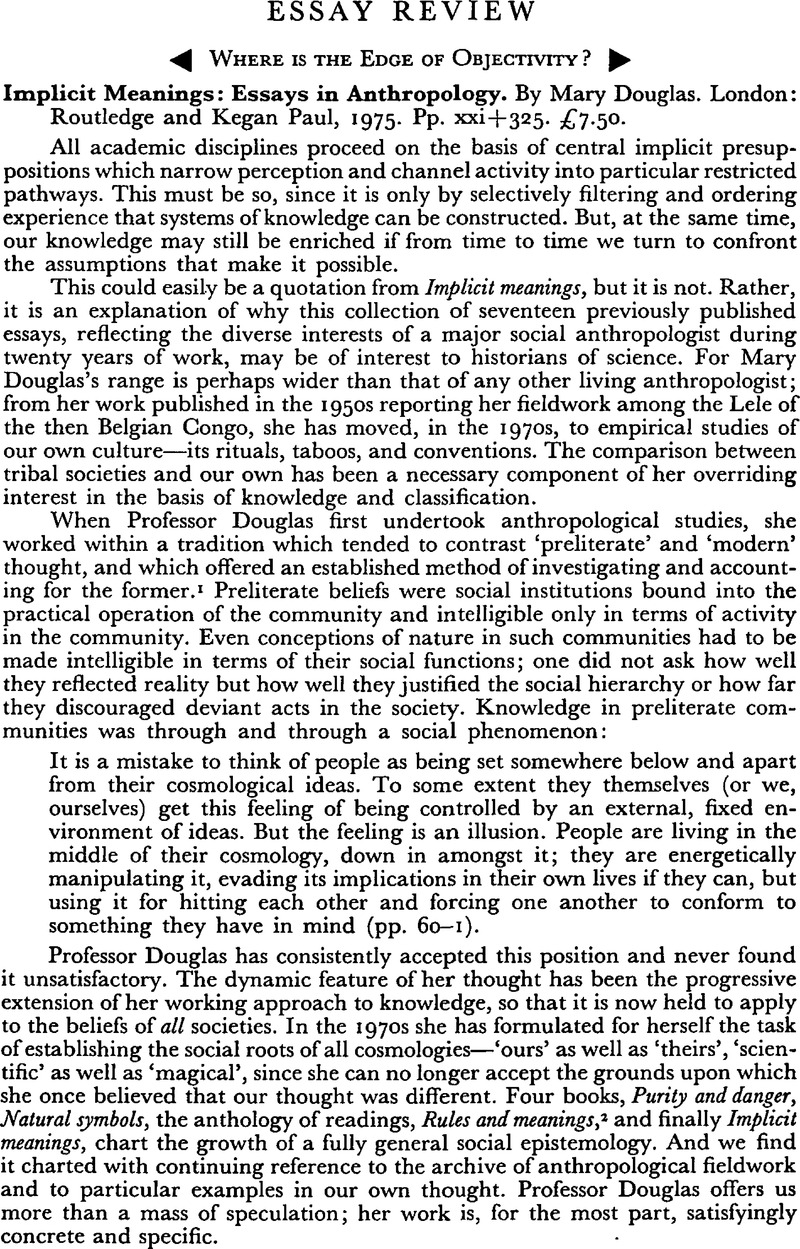Article contents
Where is the Edge of Objectivity?
Published online by Cambridge University Press: 05 January 2009
Abstract

- Type
- Essay Review
- Information
- Copyright
- Copyright © British Society for the History of Science 1977
References
NOTES
1 Cf. Durkheim, Emile, The elementary forms of the religious life (London, 1915)Google Scholar; Evans-Pritchard, E. E., Witchcraft oracles and magic among the Azande (London, 1937).Google Scholar
2 Purity and danger (London: Routledge and Kegan Paul, 1966)Google Scholar; Natural symbols (London: Barrie & Rockliff, The Cresset Press, 1970)Google Scholar; Rules and meanings (Harmondsworth: Penguin, 1973).Google Scholar
3 E.g. McGuire, J. E. and Rattansi, P. M., ‘Newton and the “Pipes of Pan”’, Notes and records of the Royal Society of London, xxi (1966), 108–43CrossRefGoogle Scholar; McGuire, J. E., ‘Force, active principles, and Newton's invisible realm’, Ambix, xv (1968), 157–208.Google Scholar
4 Cowan, Ruth Schwartz, ‘Francis Galton's statistical ideas: the influence of eugenics’, Isis, lxiii (1972), 509–28.CrossRefGoogle Scholar
5 Forman, Paul, ‘Weimar culture, causality and quantum theory, 1918–1927: adaptation by German physicists and mathematicians to a hostile intellectual environment’, Historical studies in the physical sciences, iii (1971), 1–115CrossRefGoogle Scholar; and note the explicit appeal to anthropology in his ‘The discovery of the diffraction of X-rays by crystals: a critique of the myths’, Archive for history of exact sciences, vi (1969), 38–71.Google Scholar
6 E.g. Rudwick, M. J. S., The meaning of fossils (London: MacDonald, 1972)Google Scholar; MacKenzie, Donald and Barnes, Barry, ‘Biometrician versus Mendelian: a controversy and its explanation’, Kölner Zeitschrift für Soziologie und Sozialpsychologie, xviii (1975), 165–96.Google Scholar
7 E.g. Rattansi, P. M., ‘The Helmontian-Galenist controversy in Restoration England’, Ambix, xii (1964), 1–23CrossRefGoogle Scholar; Shapin, S., ‘Phrenological knowledge and the social structure of early nineteenth-century Edinburgh’, Annals of science, xxxii (1975), 219–43.CrossRefGoogle Scholar
8 Notably his ‘Malthus and the evolutionists: the common context of biological and social theory’, Past and present, No. 43 (1969), 109–45Google Scholar; but see also his citation of Douglas's views in ‘The historiographic and ideological contexts of the nineteenth-century debate on man's place in nature’, in Teich, M. and Young, R. M. (eds.), Changing perspectives in the history of science (London: Heinemann, 1973), pp. 344–438 (434–5).Google Scholar
9 E.g. Jacob, M. C., ‘The Church and the formulation of die Newtonian world-view’, Journal of European studies, i (1971), 128–48CrossRefGoogle Scholar; and ‘John Toland and the Newtonian ideology’, Journal of the Warburg and Courtauld Institutes, xxxii (1969), 307–31.Google Scholar
10 Hill, Christopher, ‘William Harvey and the idea of monarchy’, Past and present, No. 37 (1964), 54–72.CrossRefGoogle Scholar
11 Miller, Jonathan, ‘The dog beneath the skin’, The listener (20 07 1972), pp. 74–6.Google Scholar
12 Cf. Bloor, David, ‘Wittgenstein and Mannheim on the sociology of mathematics’, Studies in history and philosophy of science, iv (1973), 173–91CrossRefGoogle Scholar; Barnes, Barry, Scientific knowledge and sociological theory (London: Routledge and Kegan Paul, 1974).Google Scholar
13 Hesse, Mary, The structure of scientific inference (London: Macmillan, 1974)Google Scholar; Bloor, David, ‘Epistemology or psychology?’, Studies in history and philosophy of science, v (1974–1975), 382–95Google Scholar; idem., Knowledge and social imagery (London: Routledge and Kegan Paul, 1976)Google Scholar. Cf. also Bhaskar, Roy, A realist theory of science (Leeds: Leeds Books, 1975).Google Scholar
- 3
- Cited by


